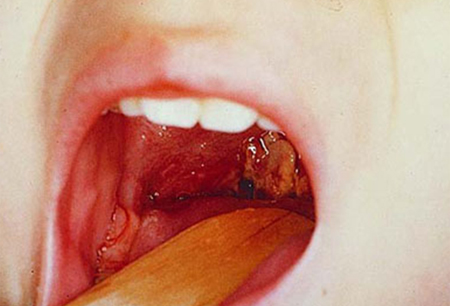History and exam
Your Organizational Guidance
ebpracticenet urges you to prioritize the following organizational guidance:
Acute KeelpijnPublished by: Werkgroep Ontwikkeling Richtlijnen Eerste Lijn (Worel)Last published: 2017Mal de gorge aiguPublished by: Groupe de Travail Développement de recommmandations de première ligneLast published: 2017Key diagnostic factors
common
child or adolescent age
winter or spring season (in bacterial pharyngitis)
Acute group A Streptococcus pharyngitis is most frequent in the winter (or early spring) in temperate climates.[1]
summer/fall season (in enteroviral pharyngitis)
rhinorrhea, nasal congestion, hoarseness, oral ulcers, and cough (in viral infection)
sore throat
Sore throat is a common symptom.[4]
pharyngeal exudate
The presence of a pharyngeal exudate is common in group A Streptococcus pharyngitis, but can also be seen in disease due to other agents including Epstein-Barr virus, other streptococci, and Francisella tularensis.
cervical adenopathy
Presence of painful anterior cervical adenopathy and absence of cough have the highest specificity for predicting streptococcal etiology.[27]
fever
Fever is common in pharyngitis and is a nonspecific symptom.
conjunctivitis
Common in measles and in pharyngitis due to viral infection.[4]
maculopapular rash (in measles)
Characteristic maculopapular rash is common in measles.
Koplik spots (in measles)
Koplik spots (bluish-white, raised lesions on an erythematous base on the buccal mucosa) are pathognomonic for measles.[6]
uncommon
scarlatiniform rash (in group A Streptococcus [GAS] pharyngitis)
Scarlatiniform rash may be present, especially in children, and is suggestive of GAS.[1]
Other diagnostic factors
uncommon
sexual activity or abuse (in HIV, gonorrheal, or chlamydial infection)
HIV, gonorrhea, and chlamydia should be considered as causative organisms in sexually active or abused individuals with pharyngitis.[10]
treatment failure of penicillin
Treatment failure in a patient without laboratory confirmation of group A Streptococcus (GAS) should prompt culture for bacterial agents other than GAS, and examination for evidence of viral disease.
pharyngeal ulceration (in tularemia)
pharyngeal gray membrane (in diphtheria)
Diphtheria should be considered if a gray membrane is identified in the pharynx or nares.[Figure caption and citation for the preceding image starts]: Typical pseudomembrane of diphtheria pharyngitisCopyright Department of Pediatrics and Adolescent Medicine, Princess Margaret Hospital, Hong Kong; used with permission [Citation ends].
Tularemia may mimic membranous diphtheria.
Risk factors
strong
nasal colonization with group A Streptococcus (GAS)
Pharyngitis is most common in the winter (or early spring), when nasopharyngeal colonization with GAS reaches up to 20% of children.[1]
GAS-infected contact
Transmission of GAS pharyngitis from infected individuals to close contacts occurs frequently through saliva, wound exudates, or nasal secretions.[4]
sexual activity or abuse
HIV infection, chlamydia, and gonorrhea should be considered as causes in sexually active or abused individuals with pharyngitis, especially in those with negative testing for GAS.[10]
ingestion of nondomestic meats
immunocompromised host
Candida pharyngitis is commonly seen in the presence of immunocompromise (e.g., after solid-organ transplantation or chemotherapy, and in individuals with HIV infection).
use of inhaled corticosteroids
Inhaled corticosteroids are associated with Candida pharyngitis. Patients may have pharyngeal involvement without overt oral thrush.[22]
lack of immunization or vaccine failure
Lack of vaccination may predispose to diphtheria or measles.
Use of this content is subject to our disclaimer